I have this speaker I designed and built almost 10 years ago, AE TD15M in 5cu.ft reflex with BMS 4550 on QSC waveguide, active with MiniDSP 2x4 and 4 channels of ICEpower 50ASX2. I've been doing some modifications and improvements, such as bracing and absorption and was taking measurements to re-evaluate the crossover.
When measuring the impedance for the tweeter, I get wiggles on the response curve. I don't recall these from back then, nor from other drivers, but it's been a long time and I used different gear and software back then. Here are a few traces I took as a bit of a sanity check. I'm using REW with a Behringer UCA222 interface and impedance jig with 96ohm resistor, full-calibration.
In case the naming conventions in my legend are a bit arcane:
Violet: 8R2 resistor
Yellow: naked BMS 4540ND, on the edge of a table
Blue: BMS 4540ND on JBL 6" PT waveguide, on the edge of a table
Green: BMS 4550 (unit A) on QSC waveguide, mounted on the enclosure
Red: BMS 4550 (unit B) on QSC waveguide, mounted on the enclosure
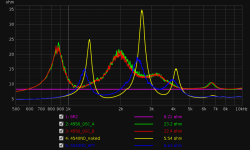
I wasn't up to detaching a 4550 from the speaker when measuring the above, but a recent 'naked' measurement showed a fairly 'clean' trace, comparable to the naked 4540ND.
It seems that the waveguide-mounted drivers have that wiggle. I was first doubting the seal of the BMS 4550 on the QSC, as I had noticed a certain bow of the mounting flange, but sanded the brackets slightly to bring it back flat and the driver exit seems quite well-fitted to the throat, with slight compression of the gasket material. The BMS 4540ND also fits the 6" JBL waveguide like a shoe, it's like they were made for each other.
My concern was initially with similar ripple on the IR of the tweeter, but I can't do anything louder than impedance measurements at this time in the evening, so hence the impedance comparison above. Here are the IR traces still, tweeter's to begin.

The woofer's IR does not have these OTOH.
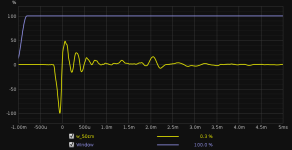
So what could be going on here?
When measuring the impedance for the tweeter, I get wiggles on the response curve. I don't recall these from back then, nor from other drivers, but it's been a long time and I used different gear and software back then. Here are a few traces I took as a bit of a sanity check. I'm using REW with a Behringer UCA222 interface and impedance jig with 96ohm resistor, full-calibration.
In case the naming conventions in my legend are a bit arcane:
Violet: 8R2 resistor
Yellow: naked BMS 4540ND, on the edge of a table
Blue: BMS 4540ND on JBL 6" PT waveguide, on the edge of a table
Green: BMS 4550 (unit A) on QSC waveguide, mounted on the enclosure
Red: BMS 4550 (unit B) on QSC waveguide, mounted on the enclosure

I wasn't up to detaching a 4550 from the speaker when measuring the above, but a recent 'naked' measurement showed a fairly 'clean' trace, comparable to the naked 4540ND.
It seems that the waveguide-mounted drivers have that wiggle. I was first doubting the seal of the BMS 4550 on the QSC, as I had noticed a certain bow of the mounting flange, but sanded the brackets slightly to bring it back flat and the driver exit seems quite well-fitted to the throat, with slight compression of the gasket material. The BMS 4540ND also fits the 6" JBL waveguide like a shoe, it's like they were made for each other.
My concern was initially with similar ripple on the IR of the tweeter, but I can't do anything louder than impedance measurements at this time in the evening, so hence the impedance comparison above. Here are the IR traces still, tweeter's to begin.

The woofer's IR does not have these OTOH.

So what could be going on here?
Last edited:
What measurement gear and settings did you use? Could it be that the assembled drivers pick up a HF sound that disturbs the measurement?
I have some questioning regarding a different issue measuring this same speaker, so I'll give this a bump instead of making another thread, maybe get a few more views and hopefully an opinion on the above.
My cabinets are quite large at over 7cu.ft external and roughly 115lb. I still managed to boost them up to have the Y-axis acoustic center-point between the TD15M and QSC waveguide be at ~4ft up, so midway to my 8ft ceiling. Other room boundaries are farther out. For a 100cm (39") measurement position, with the mic 48" up, I calculate just under 5ms for the first reflection. Perhaps a bit lower in reality as each driver is a bit closer to either floor or ceiling.
Here is the woofer's IR at 1m;
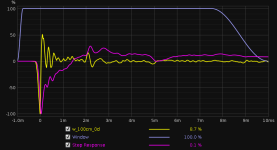
and at 50cm.
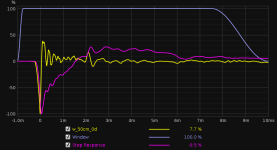
I was first scratching my head with the 2ms blip, but I guess It's a driver thing? It is unchanged with measuring distance afterall. I seem to remember another TD15M user chasing a similar issue, I'd have to search.
So on the 1m IR, would the slight dip before 5ms be my first reflection? It would check out that the ~6ms dip on the 50cm IR be the first reflection as well. They would just be smaller in amplitude than I expected.
My cabinets are quite large at over 7cu.ft external and roughly 115lb. I still managed to boost them up to have the Y-axis acoustic center-point between the TD15M and QSC waveguide be at ~4ft up, so midway to my 8ft ceiling. Other room boundaries are farther out. For a 100cm (39") measurement position, with the mic 48" up, I calculate just under 5ms for the first reflection. Perhaps a bit lower in reality as each driver is a bit closer to either floor or ceiling.
Here is the woofer's IR at 1m;

and at 50cm.

I was first scratching my head with the 2ms blip, but I guess It's a driver thing? It is unchanged with measuring distance afterall. I seem to remember another TD15M user chasing a similar issue, I'd have to search.
So on the 1m IR, would the slight dip before 5ms be my first reflection? It would check out that the ~6ms dip on the 50cm IR be the first reflection as well. They would just be smaller in amplitude than I expected.
markbakk,
You replied while I was typing the above. 🙂
Measurement gear is Dayton USB mic, with calibration file, REW and UCA-222 USB interface for the outgoing signal. Settings, whatever is standard in REW, amplitude -10dBFS, I don't calibrate for 2.83V or anything, but play it loud enough to REW's 'liking' and that I usually cover my ears during a sweep.
I doubt there is any pick-up of noise. I think the TD15M's large surface would be more prone to do so than the CD and its smaller diaphragm behind a phase-plug. At least when measuring Z of various cones and CD's on my kitchen table, ambient interference certainly seemed to be picked up by cones more.
Looking at lots of other crossover and measurement topics the last couple of days, I may have seen similar wiggles on other's CD-horn measurements, but without explanations and was not brought up as an issue in itself. I'd still like to understand this.
A wiggle-free trace on the naked compression drivers make me want to rule-out throat or mouth reflections, as they'd be minimized on the horns I mentioned above versus the driver unloading in free-space.
You replied while I was typing the above. 🙂
Measurement gear is Dayton USB mic, with calibration file, REW and UCA-222 USB interface for the outgoing signal. Settings, whatever is standard in REW, amplitude -10dBFS, I don't calibrate for 2.83V or anything, but play it loud enough to REW's 'liking' and that I usually cover my ears during a sweep.
I doubt there is any pick-up of noise. I think the TD15M's large surface would be more prone to do so than the CD and its smaller diaphragm behind a phase-plug. At least when measuring Z of various cones and CD's on my kitchen table, ambient interference certainly seemed to be picked up by cones more.
Looking at lots of other crossover and measurement topics the last couple of days, I may have seen similar wiggles on other's CD-horn measurements, but without explanations and was not brought up as an issue in itself. I'd still like to understand this.
A wiggle-free trace on the naked compression drivers make me want to rule-out throat or mouth reflections, as they'd be minimized on the horns I mentioned above versus the driver unloading in free-space.
Last edited:
You CD impedance plot appears noisy. Try changing level and see if this changes the results. If it does then it's either noise or nonlinearity. I suspect nonlinearity because it goes away at HFs.
Also, if the foundation on which your driver sit is not rock solid then you can get this kind of thing.
The 2 ms. blip is not uncommon in a large driver. It is not a good thing and the best drivers don't do this.
Also, if the foundation on which your driver sit is not rock solid then you can get this kind of thing.
The 2 ms. blip is not uncommon in a large driver. It is not a good thing and the best drivers don't do this.
gedlee,
Thanks for the input. I could not play with the titular BMS 4550 on QSC, but have a loose 4540ND on JBL 6" PT I can mess with. I measured the driver naked, held down on a solid table (red trace), with JBL horn, also held on same table (green trace) and same combo, with the horn facing down on the table.
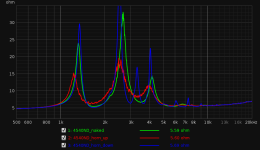
Same, zoomed-in mid-band.
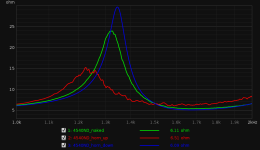
The naked driver exhibits some noise, but it's not too bad. With the horn on, it's pretty noticeable. With horn facing down, it's fairly clean. Does this mean I removed ambient noise pickup or the small leaky-sealed chamber created damped driver non-linearities?
If I have time for a second go at this today, I'll try different signal levels as you suggest.
markbakk,
My mic stand is a 0.5" steel pole, how much could reflect off of this anyway?
Thanks for the input. I could not play with the titular BMS 4550 on QSC, but have a loose 4540ND on JBL 6" PT I can mess with. I measured the driver naked, held down on a solid table (red trace), with JBL horn, also held on same table (green trace) and same combo, with the horn facing down on the table.

Same, zoomed-in mid-band.

The naked driver exhibits some noise, but it's not too bad. With the horn on, it's pretty noticeable. With horn facing down, it's fairly clean. Does this mean I removed ambient noise pickup or the small leaky-sealed chamber created damped driver non-linearities?
If I have time for a second go at this today, I'll try different signal levels as you suggest.
markbakk,
My mic stand is a 0.5" steel pole, how much could reflect off of this anyway?
It's good that you posted the impulse response (because just the electrical impedance plot leaves more questions than answers).
I've seen that before. I've always attributed those "wiggles" in the IR plot to be the major high frequency resonance of the (dome type) compression driver. In this case, however, you've got a ring radiator driver, so that wiggle (if you count the number of negative-going peaks in the IR out to 1 ms) is approximately 17 kHz. Here is a SPL response plot with harmonic distortion levels from BMS on that driver from their cut sheet:

Notice anything around 17 kHz? What you're most likely seeing is a resonance of the first bounce (i.e., half wavelength) of the driver with the horn mounted on its exit, which introduces an acoustic impedance discontinuity, i.e., a pretty good acoustic impedance bounce. This is a resonance whose characteristic half wavelength at 17 leads me to look for a cavity formed by the horn entrance and the diaphragm of about 0.4 inches. That's about what I see in this driver's geometry, although the path length forming the resonant chamber may not be straight, i.e., it could be curved somewhat.
I've seen this same phenomenon with all of my compression drivers--at some frequency close to the HF limit of response--least with the TAD TD-4002s, most with an older P.Audio BM-D750 Series I driver, which is so bad that I had to add another "way" and add a Beyma CP25, thus replacing the P.Audio driver in that frequency band above 8 kHz.
Chris
I've seen that before. I've always attributed those "wiggles" in the IR plot to be the major high frequency resonance of the (dome type) compression driver. In this case, however, you've got a ring radiator driver, so that wiggle (if you count the number of negative-going peaks in the IR out to 1 ms) is approximately 17 kHz. Here is a SPL response plot with harmonic distortion levels from BMS on that driver from their cut sheet:
Notice anything around 17 kHz? What you're most likely seeing is a resonance of the first bounce (i.e., half wavelength) of the driver with the horn mounted on its exit, which introduces an acoustic impedance discontinuity, i.e., a pretty good acoustic impedance bounce. This is a resonance whose characteristic half wavelength at 17 leads me to look for a cavity formed by the horn entrance and the diaphragm of about 0.4 inches. That's about what I see in this driver's geometry, although the path length forming the resonant chamber may not be straight, i.e., it could be curved somewhat.
I've seen this same phenomenon with all of my compression drivers--at some frequency close to the HF limit of response--least with the TAD TD-4002s, most with an older P.Audio BM-D750 Series I driver, which is so bad that I had to add another "way" and add a Beyma CP25, thus replacing the P.Audio driver in that frequency band above 8 kHz.
Chris
I'd check the whole system for some cracks, or rattles - system integrity. Do a sweep and see if you hear any buzzes. Hold the driver in your hands and do the impedance.
Cask05,
interesting thing to consider, as both 4550 and 4540ND have peaking in the 17-18kHz region. I don't have other CD's to compare.
gedlee,
I now remember having measured the impedance of the unmounted 4550 & QSC combo a few weeks ago and it showed that wiggle, but I brushed that aside, not expecting it to show up when mounted. I've since modified the bowed mounting brackets so the driver sits flatter on the flange and damped the waveguide with 2lb of duct-seal. The only common factor to the wiggle seems to be when mounted on the horn, for both drivers and WG's. I did run a few sine sweeps yesterday to measure vent output, but did not hear rattles or buzzing.
What do you think of what Cask05 mentioned in post #8? You must have tested your fair share of CD's.
interesting thing to consider, as both 4550 and 4540ND have peaking in the 17-18kHz region. I don't have other CD's to compare.
gedlee,
I now remember having measured the impedance of the unmounted 4550 & QSC combo a few weeks ago and it showed that wiggle, but I brushed that aside, not expecting it to show up when mounted. I've since modified the bowed mounting brackets so the driver sits flatter on the flange and damped the waveguide with 2lb of duct-seal. The only common factor to the wiggle seems to be when mounted on the horn, for both drivers and WG's. I did run a few sine sweeps yesterday to measure vent output, but did not hear rattles or buzzing.
What do you think of what Cask05 mentioned in post #8? You must have tested your fair share of CD's.
Regarding the ~2.5ms blip on the TD15M, I remembered correctly that member "dumptruck" noticed that when building his own speaker in parallel with mine, as well as Gary Dahl in the "Beyond the Ariel" giga-thread.
https://www.diyaudio.com/community/threads/beyond-the-ariel.100392/page-348#post-2260991
https://www.diyaudio.com/community/threads/beyond-the-ariel.100392/page-348#post-2260991
Once more with the 2.5ms blip on the TD15M IR...
If I take the REW measurement in VituixCAD and steeply (8-pole) low-pass filter the driver around 1500Hz, it seems to reduce the IR blip and the associated ripples in the frequency response, which are now buried deep in the cut-band naturally. I read before of this driver having "issues" around 800Hz IIRC as well, but my 4.75ms gate isn't letting me see anything too hi-res in that region. The 1250Hz LR4 I've been using for years isn't doing too good of a job at this though.
If I take the REW measurement in VituixCAD and steeply (8-pole) low-pass filter the driver around 1500Hz, it seems to reduce the IR blip and the associated ripples in the frequency response, which are now buried deep in the cut-band naturally. I read before of this driver having "issues" around 800Hz IIRC as well, but my 4.75ms gate isn't letting me see anything too hi-res in that region. The 1250Hz LR4 I've been using for years isn't doing too good of a job at this though.
Regarding the ~2.5ms blip on the TD15M, I remembered correctly that member "dumptruck" noticed that when building his own speaker in parallel with mine, as well as Gary Dahl in the "Beyond the Ariel" giga-thread.
Could be back-of-cone reflection off the driver's spider. This is something that I was extremely surprised to see in other drivers.
It wasn't until the spider reflection thing was mentioned by a mentoring loudspeaker engineer (~14 years go) that I realized that even driver manufacturers have their own issues with their products that they don't really address. It is apparently one of the screening criteria used for his candidate driver pool.
You could try to cut out the spider a little to change the presented area to change the severity of the acoustic reflection, but most people look at drivers as "gospel", and don't do anything to them. The mentor that I mentioned isn't one of those guys, and regularly changes things from vendors (which the manufacturers are apparently happy to oblige in production runs).
Chris
Last edited:
From what I've researched so far, I`m thinking the 2.5ms blip might be a circumferential mode, causing a dip in the mid-300Hz region and the issues higher up. Perhaps the curvilinear profile being 'flatter' towards its edge versus a cone lacks axial stiffness, compounded by its thinness and what I assume is somewhat low damping from the accordion surround, could be factors at play.
I don't think I'm brave enough to physically hack or irreversibly modify a driver whose cost approaches a mortgage payment per unit. I was thinking of designing a passive crossover for this one, but in the region I'm stuck doing so - even then for a compromised DI-matching - I think I should stick to DSP and see if I can somehow minimize this, though I won't get my hopes too high.
I don't think I'm brave enough to physically hack or irreversibly modify a driver whose cost approaches a mortgage payment per unit. I was thinking of designing a passive crossover for this one, but in the region I'm stuck doing so - even then for a compromised DI-matching - I think I should stick to DSP and see if I can somehow minimize this, though I won't get my hopes too high.
The wiggles on the impedance curves are measurement artefacts, not something that's in the drivers. The reason the wiggles go away at high frequencies is most likely the data smoothing on the log-scaled frequency axis. As already suggested by others, try improving your measurement setup (sufficient voltage/drive levels, suitable reference resistor value, solid mounting of drivers, etc.). Also make sure the software settings are right.
The characteristic delay from the spider would be on the order of 0.7 ms round trip, so this isn't a reasonable explanation for a 2.5 ms delay reflection.Could be back-of-cone reflection off the driver's spider.
Perhaps the curvilinear profile being 'flatter' towards its edge versus a cone lacks axial stiffness, compounded by its thinness
Something having a return reflection distance corresponding to a 2.5 ms delay would have to be about 17 inches away. That likely rules out acoustic reflections on the driver itself.
Any issues with nearby objects or reflections from inside an enclosure?
Chris
mbrennwa,
Thanks for the input. I'm fairly certain my setup is correct. I will nevertheless make sure of it and might be able to use a small soundproof booth for my measurement to rule out ambient sound pickup as well.
Cask05,
As concluded by Gary Dahl in the Ariel thread, the 2.5ms blip appears regardless of the driver's location or mounting to a baffle/enclosure. It is an artefact of the driver itself, like gedlee mentionned earlier. As to what aspect of its design causes it,I would not be able to say for with certitude. More than once I've read of TD15M users preferring to low-pass around 800-900Hz, this could have been a factor. I can not go that low with the QSC waveguide, so will have to live with it. The driver still does a lot of things very well, I won't get bogged down with this.
Thanks for the input. I'm fairly certain my setup is correct. I will nevertheless make sure of it and might be able to use a small soundproof booth for my measurement to rule out ambient sound pickup as well.
Cask05,
As concluded by Gary Dahl in the Ariel thread, the 2.5ms blip appears regardless of the driver's location or mounting to a baffle/enclosure. It is an artefact of the driver itself, like gedlee mentionned earlier. As to what aspect of its design causes it,I would not be able to say for with certitude. More than once I've read of TD15M users preferring to low-pass around 800-900Hz, this could have been a factor. I can not go that low with the QSC waveguide, so will have to live with it. The driver still does a lot of things very well, I won't get bogged down with this.
I agree.The wiggles on the impedance curves are measurement artefacts, not something that's in the drivers. The reason the wiggles go away at high frequencies is most likely the data smoothing on the log-scaled frequency axis. As already suggested by others, try improving your measurement setup (sufficient voltage/drive levels, suitable reference resistor value, solid mounting of drivers, etc.). Also make sure the software settings are right.
There is nothing in the lumped parameter model that would allow for such ripples. It has to be in the setup. Frequency spacing looks like maybe hum? And yes, of course, the ripples fade as the averaging gets wider.
As to the hump at 2.5 ms. I suspect that the spider is going into resonance. That's hard to fix after the fact. The sound doesn't bounce off the spider as much as the spider just goes into resonance like a drum. This sends a signal back to the cone and generally there is a ripple in the passband and a late arriving pulse in the impulse.
I suppose that inexpensive UCA-222 interface could cause some issues. With a compression driver connected, I can put my ear to the exit and hear next to nothing - that is until I open REW's "Measure" screen. I suppose it opens-up the audio stream and I can then hear a periodic noise - which I can also see on the monitoring mini-scope of the same screen, when connecting the DUT.
Still, my test signal is usually 30dB or more above that elevated noise floor, so I wonder why the issue is exacerbated simply by putting a horn on the driver and OTOH almost nullified by placing the horn face down on a vinyl-covered hard surface.
I also tried the headphone output from two laptops; I can still hear the same jittery, pulsated 'whine' and the impedance traces come out similar.
Not that huge a deal I suppose, since it is only for personal use. 1/48-oct smoothing shaves-that right off in any case.
Still, my test signal is usually 30dB or more above that elevated noise floor, so I wonder why the issue is exacerbated simply by putting a horn on the driver and OTOH almost nullified by placing the horn face down on a vinyl-covered hard surface.
I also tried the headphone output from two laptops; I can still hear the same jittery, pulsated 'whine' and the impedance traces come out similar.
Not that huge a deal I suppose, since it is only for personal use. 1/48-oct smoothing shaves-that right off in any case.
- Home
- Loudspeakers
- Multi-Way
- Wiggles / ripple on impedance response